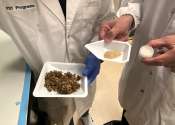Last update:
Biotechnology news

Researchers train a bank of AI models to identify memory formation signals in the brain
An international research collaboration between Vanderbilt University and the Madrid-based de la Prida lab in the Cajal Institute led to the development of AI models that detect and analyze hippocampal ripples, which are ...
Biotechnology
10 hours ago
0
18

Arboviruses, mosquitoes and potential hosts tracked in real time in São Paulo city
The technology used to sequence SARS-CoV-2 at record speed early in the COVID-19 pandemic has been successfully tested as a technique to monitor arboviruses and diseases transmitted mainly by mosquitoes.
Biotechnology
Apr 17, 2024
0
8

Electronic tongue can detect white wine spoilage before humans can
While the electronic tongue bears little physical resemblance to its namesake, the strand-like sensory probes of the "e-tongue" still outperformed human senses when detecting contaminated wine in a recent study.
Biotechnology
Apr 17, 2024
0
14

Neuronal gateway to essential molecules in learning and memory discovered on atomic scale
Learning from an experience, remembering an anecdote or changing an attitude are examples that reveal how all our behavior is the result of the exchange of chemical compounds—neurotransmitters—between neurons. Unraveling ...
Biotechnology
Apr 17, 2024
0
34

Making crops colorful for easier weeding by robots
To make weeding easier, scientists suggest bioengineering crops to be colorful or to have differently shaped leaves so that they can be more easily distinguished from their wild and weedy counterparts. This could involve ...
Biotechnology
Apr 17, 2024
0
0

Disease-resistant strains of carp provide advancements in aquaculture, enhance gefilte fish quality
A new study led by Prof. Lior David from the Faculty of Agriculture at the Hebrew University investigated the infectivity of disease-resistant and susceptible fish by examining their roles as shedders (infecting) and cohabitants ...
Biotechnology
Apr 17, 2024
0
6

Computer model suggests frozen cells could be used to save northern white rhino from extinction
A team of geneticists and computer scientists from the San Diego Zoo Wildlife Alliance, Cornell University and the University of California, Santa Cruz, has created a computer model that shows it should be possible to save ...

A nematode gel to protect crops in Africa and Asia
The fall armyworm is a destructive corn pest that recently arrived in Africa and Asia from the Americas and began causing major yield losses and increased use of insecticides, which pose environmental and human health risks.
Biotechnology
Apr 17, 2024
0
12

Plant sensors could act as an early warning system for farmers
Using a pair of sensors made from carbon nanotubes, researchers from MIT and the Singapore-MIT Alliance for Research and Technology (SMART) have discovered signals that reveal when plans are experiencing stresses such as ...
Biotechnology
Apr 17, 2024
0
28

Physical field technologies to improve extraction and quality of extracted juices
Consumers are increasingly health-conscious and seek products with minimal additives and preservatives. The modern consumer understands the link between consuming bioactive compounds from fruits and vegetables and the associated ...
Cell & Microbiology
Apr 16, 2024
0
1

Study shows insect diet is reflected by the wear and tear on their jaws
Show me your jaw and I'll tell you what you eat: This could be the motto of a study conducted at Kiel University (CAU) and the University of Tokyo. The researchers investigated whether the wear and tear on insect mouthparts ...
Ecology
Apr 16, 2024
0
5

New tagging method provides bioadhesive interface for marine sensors on diverse, soft and fragile species
Tagging marine animals with sensors to track and study their movements can provide researchers with important environmental and behavioral information, including energy usage, habitat changes, and migration patterns. But ...
Ecology
Apr 16, 2024
0
99

The role of GEDI LiDAR technology in unlocking the secrets of tree height composition
A team of researchers has unveiled a novel approach to accurately characterizing tree height composition in forests using the Global Ecosystem Dynamics Investigation (GEDI) Light Detection and Ranging (LiDAR) technology. ...
Ecology
Apr 15, 2024
0
1

Millions of gamers advance biomedical research by helping to reconstruct microbial evolutionary histories
Leveraging gamers and video game technology can dramatically boost scientific research, according to a new study published today in Nature Biotechnology.
Cell & Microbiology
Apr 15, 2024
0
300

AI is giving boost to crop improvement research
What is the role of artificial intelligence for crop improvement? Questions about artificial intelligence are becoming more pressing in every discipline. For crop improvement, AI provides a new lens to bridge science and ...
Biotechnology
Apr 12, 2024
0
5

3D microelectrode chip helps soil nutrient analysis
Researchers have developed a novel microfluidic chip with capacitively coupled contactless conductivity detection (C4D) integrated 3D microelectrodes to rapidly and quantitatively determine abundant nutrient ions in soil.
Biotechnology
Apr 12, 2024
0
1

New CRISPR tool orchestrates antiviral defense within cells
The rise of RNA viruses like SARS-CoV-2 highlights the need for new ways to fight them. RNA-targeting tools like CRISPR/Cas13 are powerful but inefficient in the cytoplasm of cells, where many RNA viruses replicate.
Biotechnology
Apr 12, 2024
0
99

Microbial food as a food production strategy of the future
The global food crisis is increasing due to rapid population growth and declining food productivity from climate change. Moreover, today's food production and supply system emits a huge amount of carbon dioxide, reaching ...
Cell & Microbiology
Apr 12, 2024
0
53

Researchers develop method to extract useful proteins from beer-brewing leftovers
Researchers from Nanyang Technological University, Singapore (NTU Singapore), have created a method that extracts more than 80% of the available protein in grain leftovers from brewing beer, commonly known as brewers' spent ...
Biotechnology
Apr 11, 2024
0
122

Developing nutrient-rich fertilizer from toxic ammonia
Researchers have recently found out how to use algae to convert ammonia and nitrates into a nutrient-rich fertilizer or fish feed ingredients.
Biotechnology
Apr 11, 2024
0
11
More news

When an antibiotic fails: Scientists are using AI to target 'sleeper' bacteria

With the flick of a switch: Shaping cells with light

Q&A: The engineer who delivers mRNA inside human cells
Other news

Research team resolves decades-long problem in microscopy

RNA's hidden potential: New study unveils its role in early life and future bioengineering

Smoother surfaces make for better accelerators

NASA's Juno gives aerial views of mountain and lava lake on Io

Materials follow the 'Rule of Four,' but scientists don't know why yet

Invasive species sound off about impending ecosystem changes

Discovery of new ancient giant snake in India



























































